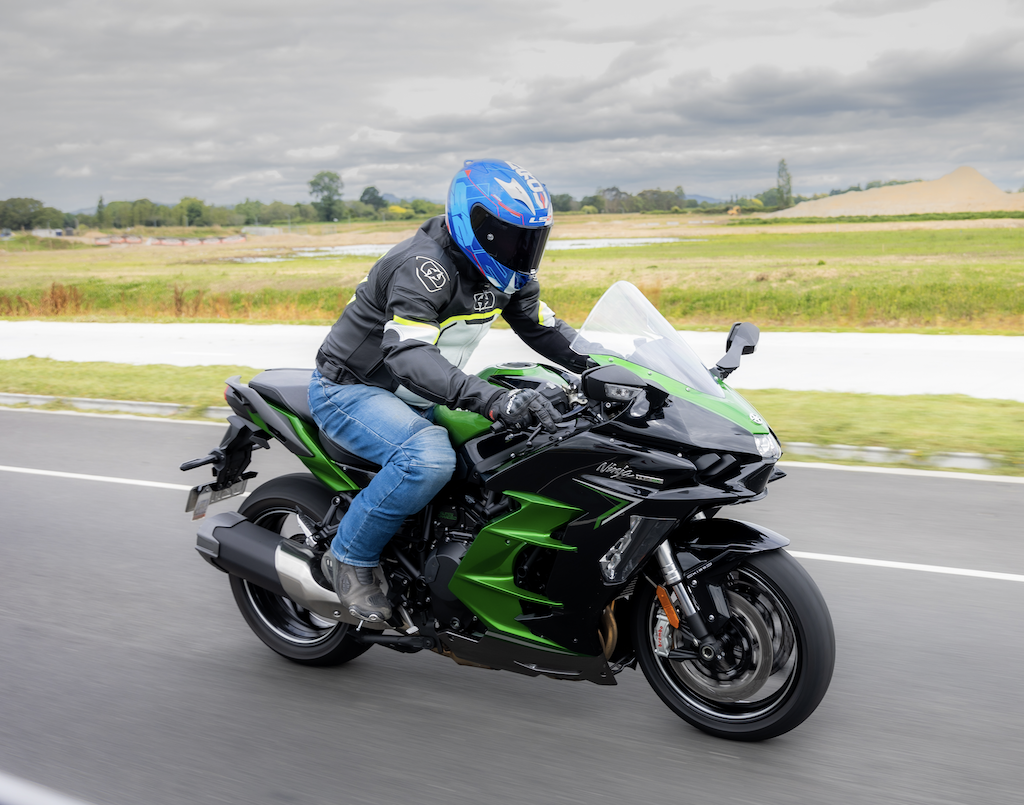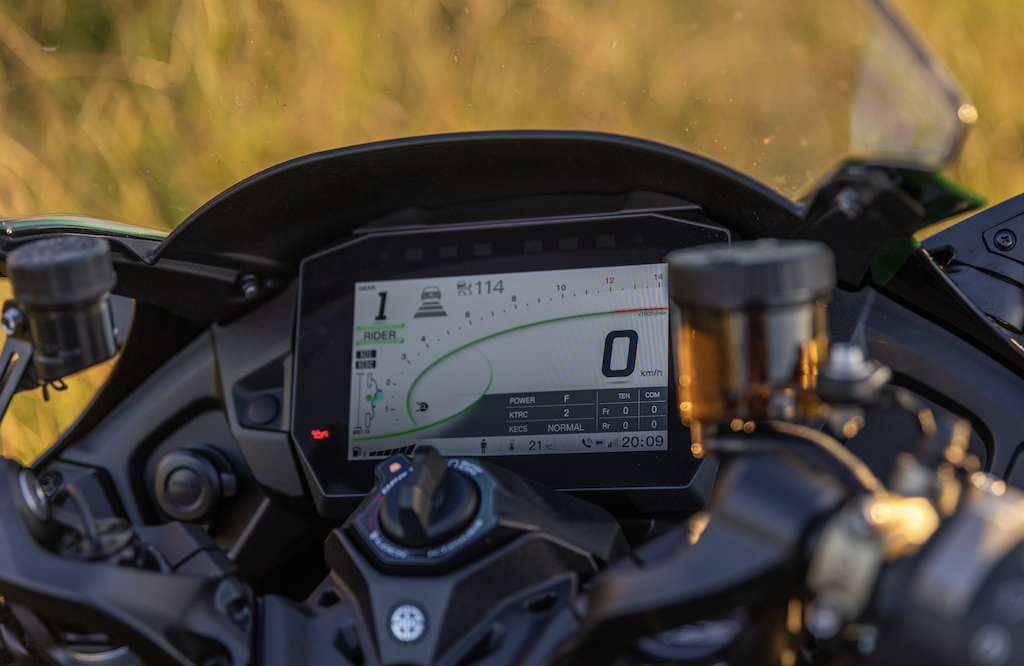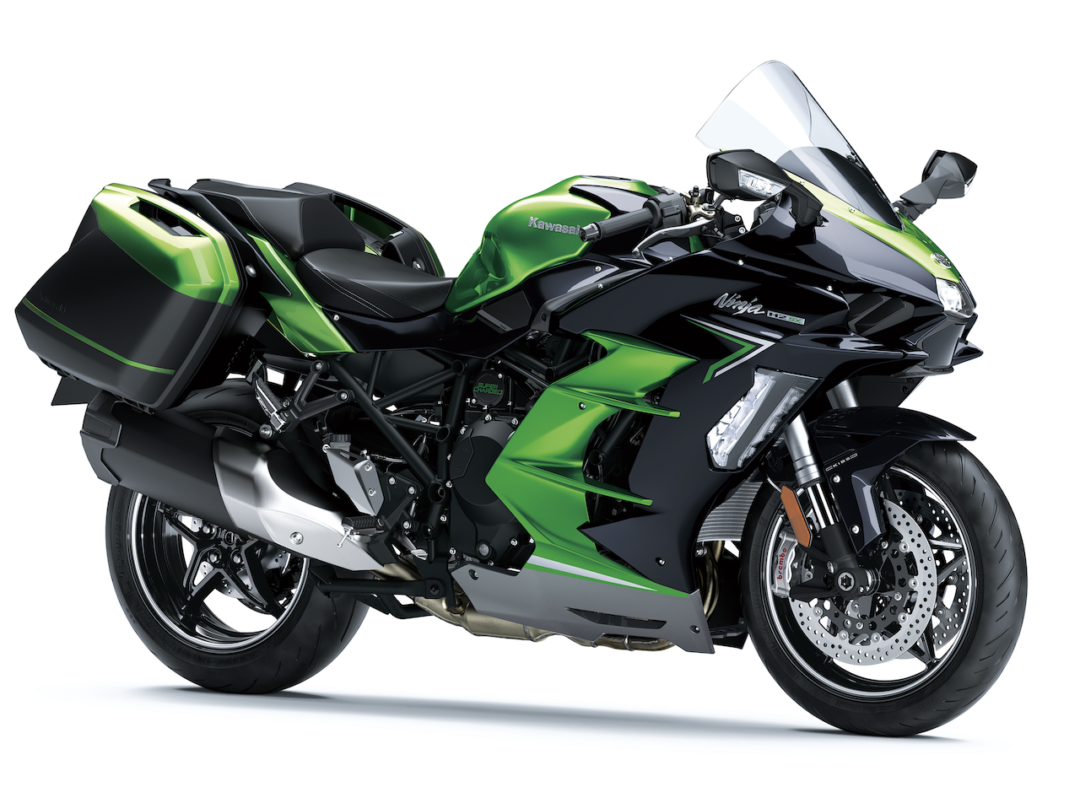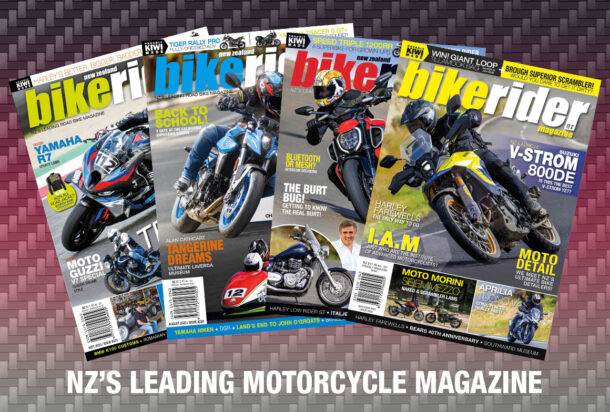We’ve ridden a few supercharged bikes recently, but none have been as smooth and refined as the incredible Ninja H2 SX SE from Kawasaki. BRM Tested!

Checking out Kawasaki’s website after being told the latest version of their supercharged tourer was available to collect, I was intrigued to read that the ‘second-generation Ninja H2 SX benefits from a host of new technology that makes it the most advanced model in Kawasaki’s fleet’. As anyone who knows me will testify, I love a gadget. But even I was a little overwhelmed when I got to Kawasaki HQ and not only received the bike and a key fob, but also a 32-page printout of model information designed to help me find my way around the features of the new H2 SX SE. Yep, they weren’t kidding!
Kawasaki is the first manufacturer to put a supercharged motorcycle into mass production, with the launch of the bonkers 300hp track-only H2R in 2015, closely followed by the road-going and slightly tamer (200hp) H2. Then came the touring version, with the H2 SX taking the mile-munching pedigree from the popular Ninja 1000 SX and combining it with the same blown powerplant, just with a couple of mods to make it more touring-friendly. The model we picked up from Kawasaki is the updated version of this original super tourer, and again, Kawasaki has managed to incorporate a number of firsts within the package of this premium tourer.
Tech’d Up
Rather than doing the usual male thing of throwing the instructions in the bin and just getting on with it, I decided this time I’d do the right thing and at least cast an eye over the paperwork before jumping on and launching up the road. And to be honest, I was glad I did. Just looking at the stuff going on with the large 6.5-inch TFT screen was enough to tell me I needed to know how to work it, and that was before I’d downloaded the Kawasaki SPIN app to my phone.
At the heart of the H2 SX is the same 998cc, four-cylinder powerplant as the original, just with a few mods to make it cleaner for Euro-5 testing while also offering a bit more torque in the mid-range. The figures produced from the inline-four are quite incredible, with a maximum horsepower output of 200hp @ 11,000rpm, while the all-important torque is a monstrous 137.3Nm at a very usable 8,500rpm. Compare that to Kawasaki’s litre superbike and you can recognise the beauty of a supercharger, with the ZX10R producing slightly more outright power at 203hp, but it’s achieved at a heady 13,200rpm. While the max torque figure of 114.9Nm is not only down on the H2 SX but it’s also higher in the rev range at 11,400rpm.
So it’s clear to see the benefit of forced induction when it comes to power and torque outputs, but what we don’t often appreciate is the benefit when it comes to emissions and fuel usage. Car manufacturers have been fitting superchargers and turbos to small-capacity engines for years now, with the result being power figures comparable with bigger powerplants with fuel consumption greatly reduced. And the Kawasaki has benefitted from the same result, with the H2 SX’s fuel consumption similar to their litre tourer, the Ninja 1000 SX or their adventure-styled Versys 1000. So, it seems, you can have your cake and eat it if you put a supercharger on your engine…
Yet it’s not just the powerplant that is special with the new Ninja H2 SX SE, with a couple of other firsts also incorporated into the big green machine. Again, using technology now commonplace on modern cars, the SX SE is the first production motorcycle to be fitted with Bosch’s Advanced Rider Assistance Systems (ARAS), which sees radar sensors mounted at the front and rear of the motorcycle. The system, combined with a new FI-ECU with torque-demand capabilities and a 6-axis IMU, gives the Ninja the ability for an adaptive cruise control system which automatically adjusts the speed of the machine to keep it a set distance from a vehicle in front. Combined with this is a Blind Spot Detection system with lights illuminating in the mirrors if there’s someone sitting where they shouldn’t, and also a Forward Collision Warning system. As I say, it’s a bike that requires you to read the instructions.
And it doesn’t stop there. As you’d expect, there’s a whole host of other electronic aids, many of which come in quite handy when exploring the reaches of a 200hp supercharged rocketship. Kawasaki’s Cornering Management Function takes information from a number of sources including the IMU during the cornering process to make the transition from braking to getting back on the throttle as smooth as possible. This involves modulating the brake force, engine power and electronic suspension to keep the bike as balanced as possible, while the cornering ABS and traction control makes sure you don’t end up in a pile should the available traction change. There’s also Launch Control, Wheelie Control, switchable power modes (which also change the parameters), a quickshifter and Engine Brake Control.
As this is the premium SE version of the H2 SX, this means it’s fitted with the excellent Showa Skyhook semi-active suspension, which uses all the information gained from the IMU and other sensors to adjust the suspension via a solenoid valve. There are three base settings to choose from (Hard/Normal/Soft) which change as you option the different riding modes, or you can set your own combination in the rider mode. The damping is adjusted electronically to suit the speed you’re riding, the suspension stroke, which determines how rough the road is and, for the first time, the pitching that takes place under acceleration and braking. And it’s fast, too, with a reaction time of 1 millisecond, meaning the suspension knows to change before you’ve even felt the bump!

The key on the H2 SX is a proximity item, meaning you don’t need to rummage around in your pockets unless you want to open the fuel tank. To start the bike the key just needs to be in proximity to the machine, which allows you to turn the knob on the headstock. There’s a tyre pressure monitoring system, hill hold control, and the indicators flash to warn other motorists if you brake too hard. In fact, the only thing missing from this flagship tourer is the luggage, with the colour-match panniers an optional extra, which is a bit rough when you’re already looking at $47k.
Finally, there’s always an app nowadays, and Kawasaki has a new SPIN system. This allows you to do all the usual things like connect your phone to the bike and then connect the bike to your Bluetooth headset and manage music, calls and messages. But the SPIN system also goes one further, allowing you to add certain apps to the dashboard of the SX and control them. Personally, riding a 200hp motorcycle tends to make me want to look at the road more than the dashboard, but then I guess this might come in handy for some.
Blowing Out
Wheeling the SX out of the shed and you get the feeling that this is quite a large bike. The wet weight of 267 kilos is partially to blame, which combined with the vast amount of aerodynamic fairing and a 1480mm wheelbase all give it a big look. To put it in context, the last ‘hyperbike’ from Kawasaki before they got into supercharging was the ZZ-R1400 which featured frighteningly similar figures, from an almost identical wheelbase (1481mm) to a 5mm shorter length (2170mm) and even a very similar wet weight of 265kilos. Yet, slipping a leg over the H2 SX saddle and settling into the riding position reveals a bike that feels sporty, almost like a more relaxed ZX10R rather than the touring style of the Ninja 1000 SX or ZZ-R. And funnily enough, looking back at the ZZ-R and it’s interesting to see the power wasn’t far off either, with the big block four-cylinder producing 197hp @ 10,500rpm and 153.5Nm @ 7500rpm. But it’s the way the supercharged machine brings the horsepower and torque into play that’s the real difference with the modern machine, as I was soon to find out.
Heading out on the road and the first bit of tech I was keen to get acquainted with was the adaptive cruise control. Pressing the button to activate the cruise on the left switchblock is easy enough before prodding the ‘set’ button below to lock the speed where it is. At the top of the dash appears the speed you’re set at and also how far you’ve got the radar set to keep you from the vehicle in front. It’s just like you’ll find on many modern cars and is just as easy to use. And with the Kawasaki’s FI-ECU, the bike can increase or decrease the bike’s speed to keep it the set distance away. It’ll even bring the brakes into play if the vehicle in front begins to slow rapidly, although the system deactivates below a certain speed determined by the gear you are in. It works well, and the ‘softness’ with which the system deactivates when you touch the brake lever or roll forward on the throttle is the best I’ve experienced. All too often, deactivating cruise control results in a clash of helmets when there’s a passenger on the back, but the H2’s system is so smooth that the pillion barely noticed.
With the main roads dispatched without incident thanks to the cruise control keeping my speed civilised, a switch off into some of my favourite backroads was the perfect opportunity to stretch the legs of the Kawasaki. And, wow, do those legs stretch! Despite the H2 SX having the same sort of output figures as the old 1400cc machine, the way the supercharger delivers torque low in the rev range would leave the analogue machine scrambling to catch up. Drive comes from as low as 2000rpm, but at 4000rpm things are getting blurry as the digital rev counter races up its slope. Hanging onto the throttle sees a more serious kick at 6 thousand before the final surge comes in at 8k. With added speed comes more pressure courtesy of the ram air duct located to the left of the central headlight, meaning there’s more air/fuel being forced into the combustion chamber. With the revs this high, things are happening rapidly, with the gear lever being tapped in unison with the shift lights illuminating across the top of the dash. The Ninja accelerates so hard and has so much drive lower in the rev range that it’s hardly worth hanging onto the extra revs up top, and on a number of occasions, I’d flick straight through third to fourth, putting the powerplant back into the meat of the supercharged torque.
Holding the throttle on the stop takes a serious amount of nerve, along with a bit of faith and a lot of room. It’s easy to think that the skill involved is all you, but then you become aware that the bike is working just as hard to keep both wheels on the ground and the maximum amount of forward drive continuing until you either run out of nerve or space and roll off the throttle. With this much instant access to astonishing power, the anti-wheelie system is keeping the front on the floor, while the electronic suspension is firming the rear shock to avoid squatting. The traction control is taking care of any slippage while the radar is looking out for any forward collisions, although at this speed I doubt if you’d have time to acknowledge the warning before coming to a very abrupt stop.
Parked up outside a café in Waihi with the H2 SX parked alongside me, I’ve never had another bike generate as much conversation from passers-by. Many recognised it as a supercharged Kawasaki and were in awe, while others just appreciated the lines and lustrous paint. And a couple sparked up the conversation with, ‘there’s no place here for a bike as fast as that nowadays.’ And, my first response was that they were probably right. But then I’d get back on, start it up and cruise off down the road with the Ninja as docile and well-behaved as any other tourer and change my mind. I’m extremely pleased that Kawasaki has continued to make these incredible supercharged machines.
Cruising along and, just like anything, it’s as fast as you want it to be. Shortshifting through the dog-ring type transmission using the quickshifter is seamless, no matter my throttle position or speed. The SX will drop to 50km/h in sixth and pull cleanly away, while overtakes rarely require more than a slight flick of my throttle hand. The saddle is large enough to move around on, and the pegs are high but not too high so as to cause aches in my knees. The 19-litre tank is enough for around 300km before drinks, enough for a decent tourer and the suspension, while firm, is composed. And if I really wanted to tame things down, a switch to Rain mode drops the power output and throttle response, making the Ninja into more of a Nana.
But when the time is right, the conditions suitable and the mood suits, that’s when this mild-mannered missile can be unleashed, with the mind-blowing acceleration so instant that a quick squirt between corners is often enough to satisfy the craving. Thankfully, the little squirt results in approaching the next corner considerably faster than I’m used to, which is when I became grateful for the stunning Brembo monoblocs which offer mind-bending stopping power using only two fingers.
Surprisingly, after multiple trips on the Ninja, I discovered my favourite trait of the package was mid-turn. Carrying the brakes into corners and the feel belies the weight that you’re carrying, with the ZX10R heritage and semi-active suspension somehow working to make the green machine far more agile than you’d expect. But it’s when you get to the point of getting back on the gas and unleashing the ferocious surge of torque that the electronics really come into their own. Whereas I expected the rear to squat, the front to lift and the SX to begin to run wide, the bike stays solid and level, with the rear simply driving you toward the exit where eventually you stand the bike up and continue to unleash the fury. It was so impressive that I attempted going in slower, nailing the throttle harder, choosing different gears and being more aggressive, but I still couldn’t get the Kawasaki to misbehave, almost as if I had an angel on my shoulder. And in a sense, I did, with Kawasaki’s KCMF monitoring and adjusting to help hold the intended line.
Sport Touring
Kawasaki has nailed supercharging motorcycles, of that there is no doubt. With a slightly changed shape and angle of the blades from the H2, the SX has been tuned for mid-range punch and there’s nothing else quite like it. I just wish there was the same amount of ‘chirping’ as the naked H2, which soon becomes addictive.
The fuelling is excellent, the electronic aids work faultlessly while the handling and riding position are on the sporty side of touring, which suits the attitude of the Ninja. While the dash looks fantastic and is easy to read, the controls are slightly convoluted, requiring a decent ride and a bit of reading to get sorted, especially when the riding bit takes up a fair amount of brain power.
The fact you need to stump up more on top of the purchase price to get the panniers seems a bit tough, but if you’re in this far then you may as well go the whole hog. And what you’ll end up with is the fastest and best-handling sports tourer available today – of that I have no doubt. Yes, it’s a little large, but then this is a sports tourer, not a superbike. And the electronics combined with the semi-active suspension somehow make the SX into a real Ninja in the turns. Yet the biggest surprise for me was the amount of attention I received while parked up with the H2 SX. I don’t think there’s another Japanese machine that has garnered this much attention in all the time I’ve been testing. So if you’re looking for something a bit special but with all the reliability and technology of a Kawasaki, then you’re going to need to pay the price.
“It seems, you can have your cake and eat it if you put a supercharger on your engine…”
“As you’d expect, there’s a whole host of other electronic aids, many of which come in quite handy when exploring the reaches of a 200hp supercharged rocketship.”
“Slipping a leg over the H2 SX saddle and settling into the riding position reveals a bike that feels sporty, almost like a more relaxed ZX10R…”
“Holding the throttle on the stop takes a serious amount of nerve, along with a bit of faith and a lot of room.”
“The electronics combined with the semi-active suspension somehow make the SX into a real Ninja in the turns.”

AT A GLANCE
Name: Kawasaki Ninja H2 SX SE | Weight: 267kg (wet)
| Power: Max Power 200hp @ 11,000 rpm (plus ram air!) / Max Torque
137Nm @ 8,500 rpm
//Front// The H2 SX has lots of electronics crammed in the front, with a radar used for the adaptive cruise control – there’s one at the rear too for the blindspot mitigation. To fit the radar at the front, the SX gets central LED lights, with the cornering lights placed lower down the fairing.
Dash A 6.5” TFT dash is filled with information and the handlebars are full of buttons, but it’s not the most intuitive system to use. Once you get your head around it you can switch between riding modes and dash layout, but it takes a while. You can also connect your phone and use the app.
Engine The 998cc four-cylinder pumps out over 200hp when you take into account the additional horses from the ram-air system. But it’s the torque that this motor is all about, with the supercharged powerplant offering masses of go from low in the rev range. And it’s useable, with the linear delivery making the SX easy to ride in town or supersonic…
Suspension The addition of the SE’s KECS electronic suspension with Skyhook technology combined with the Bosch 6-axis IMU works seamlessly to manage damping over surfaces as they change. Adding preload for a pillion is done with a press of a button, while the system also works to balance the bike while cornering or under hard acceleration.
Panniers While the SX SE is pricey at $47k, you still need to fork out extra for the colour-matched panniers. Thankfully they are pretty cool, with a clear mounting system meaning there are no ugly brackets, and it’s a one-key system. The other bonus is that one pannier hides the gigantic exhaust can!
Engine The H2 SX is Kawasaki’s first model to integrate an FI-ECU with torque demand capabilities. Linked to the IMU and ABS module, the radar system detects vehicles ahead and keeps the H2 at a pre-selected distance from the rear, increasing and decreasing speed to match, even activating the brakes if required.
Photo Credit www.twocreative.co.nz














